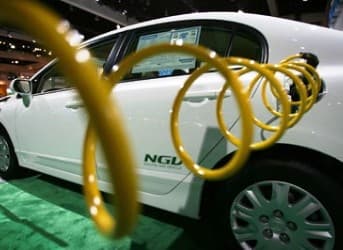We tried or at least discussed this many times before. That is, an exodus from gasoline and diesel fuel. We have yet to find the promised land of an abundant domestic resource that that is more financially sound, environmentally friendlier, market ready and convenient. The path includes just about every primary energy resource in the world’s energy inventory.
Most have failed to support the customer base at the desired cost level. EVs looked like it got the checkered flag. EVs sound good, but it too has some fundamental issues hindering growth. Loss of incentives and questions on their consumer readiness has stalled recent sales projections. Also, as long as electricity, a secondary source of energy, is primarily generated from coal and natural gas, EVs by no means have a zero carbon footprint.
Even Hybrids, the sensible bridge, are under scrutiny. The EPA is reevaluating how it rates gas mileage for hybrids to make sure the estimate gas mileage matches real-world driving. “The agency's action comes after Consumer Reports wrote that its gas mileage in real-world use of Ford's new C-Max crossover and Fusion sedan hybrids, 37 mpg and 39 overall, respectively, fell far short of their EPA ratings of 47 in mixed driving.”[1]
Below the radar, at least in the U.S., is natural gas fueled vehicles, NGVs for short. Definitely abundant, cheaper and cleaner than petroleum, natural gas seemed to make a lot of sense as an alternate fuel for the transportation sector. Also, it asked little of the customer base in terms of driving behavior. Interest was impacted by an undeveloped infrastructure and the cost to upfit a vehicle to natural gas.
The shale gas gold rush in the U.S. and the associated concern over hydraulic fracturing, “fracking,” made it nearly impossible to keep natural gas out of the limelight. Beyond electrical generation, the export market and the competitive advantages natural gas provides industrial users, there are not many more sectors where it can be absorbed by the U.S. economy. In many instances, use of natural gas only converts one domestic resource for another and does little to affect energy independence and security. For this to happen, the transportation sector, the driver of imported petroleum, must convert over to natural. It is noted that as natural gas replaces coal to generate electricity, EVs can indirectly change the need for foreign oil.
Looking at the global landscape of NGVs and CNG fueling stations, the United States although the world leader in both unconventional natural gas production and number of driver’s is ranked 15th with only 123,000 NGVs and 6th in terms of CNG fueling stations, see Figure 1. Iran, Pakistan (2,859,386 NGVs, 1,574 stations) Argentina, Brazil and China have significantly more NGVs and CNG fueling stations.
Related article: Buffett Banks on Natural Gas Trains


Figure 1
The playing field may finally be changing for NGVs! This week, the Star-Telegram and AP reported:[2]
“….. the sales of NGVs are rising”
“….. Ford sold a record 11,600 natural gas vehicles last year, more than four times the number it sold two years ago”
“….. natural gas is making inroads as a transportation fuel, particularly for truck fleets, buses and taxis. The consumer market is tougher to crack, but sales are gaining there as well.”
“GM and Chrysler recently added natural gas pickup trucks to their lineups.”
“Honda is seeing more interest in its natural gas Civic -- with record U.S. sales of nearly 2,000 last year…..”
“….. 20,381 natural gas vehicles were sold in the U.S. in 2012.”
Related article: LNG Technology: The Holy Grail of Gas Investments
In closing, this sudden spike in demand does not an industry make. Even with cheap, clean and plentiful natural gas, growth may be hampered by issues somewhat similar to EVs -- higher priced vehicles, lack of convenient fueling stations (though both NGV and EVs can be fueled/charged at home), and range anxiety (+200 mile for is substantially higher than EVs +/- 100 mile range). But with the power to operate medium- and heavy-duty vehicles, increased presence of fast fill stations (routine fast charging of EVs is questionable), capability to convert some existing vehicles to run on natural gas and an immediate savings of +$1.00 per gallon at-the-pump, this spike maybe the sign of no return. Only time will tell if growth is sustainable.
ADVERTISEMENT
By. Barry Stevens
References:
[1] “EPA evaluating how it rates gas mileage for hybrids,” Chris Woodyard, USA TODAY, February 28, 2013; http://www.usatoday.com/story/money/cars/2013/02/28/epa-gas-mileage-ford-cmax-fusion/1954967/
[2] “Sales of natural-gas powered vehicles rising,” Jim Fuquay, Star-Telegram, March 6, 2013; http://www.star-telegram.com/2013/03/06/4665519/sales-of-natural-gas-powered-vehicles.html



















Ron Wagner
Here's what the Exxon Outlook for Energy 2040 forecast says:
Diesel will surpass gasoline as the number one transportation fuel worldwide by 2020 and continue to increase its share through 2040. The relative shift away from motor gasoline to diesel is driven by improving light-duty vehicle fuel economy and the growth in commercial transportation activity. Diesel demand accounts for 70% of the growth in demand for all transportation fuels through the forecast period to 2040.
Although natural gas will play a greater role as a transportation fuel by 2040, it remains only a small share of the global transportation fuel mix, at 4% by 2040, up from today’s 1%.
http://www.greencarcongress.com/2013/03/xom-20130309.html